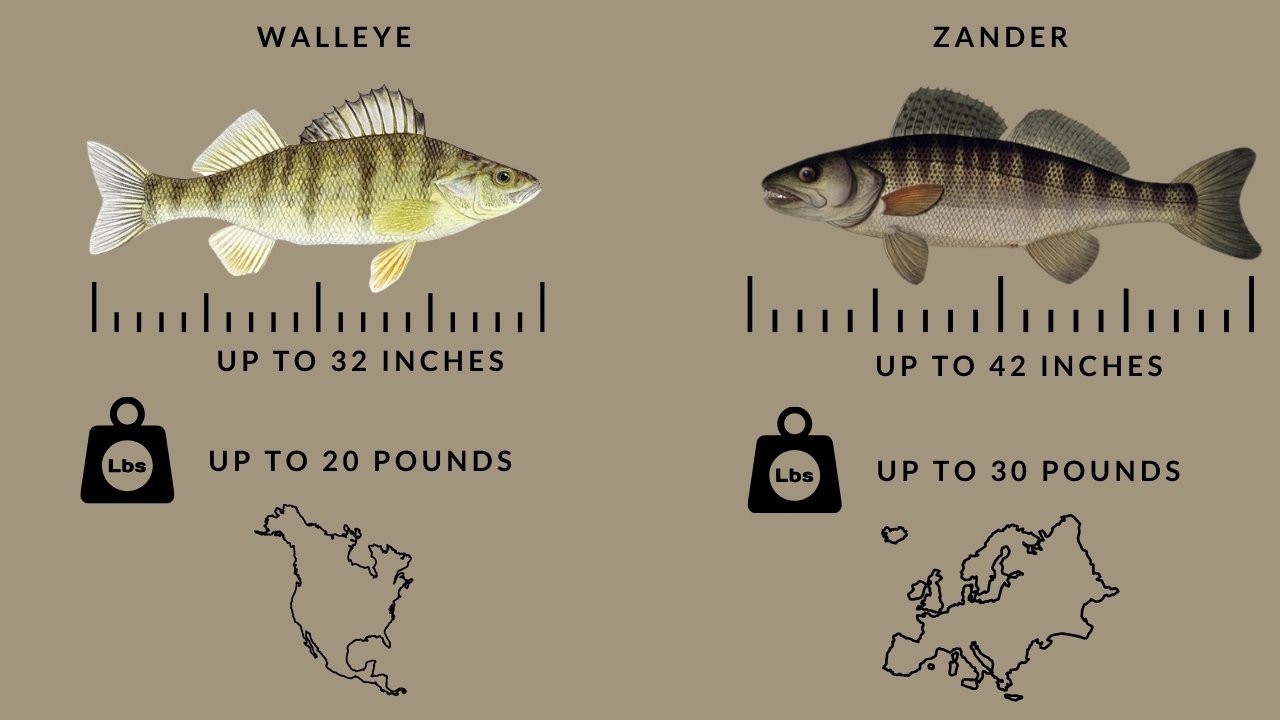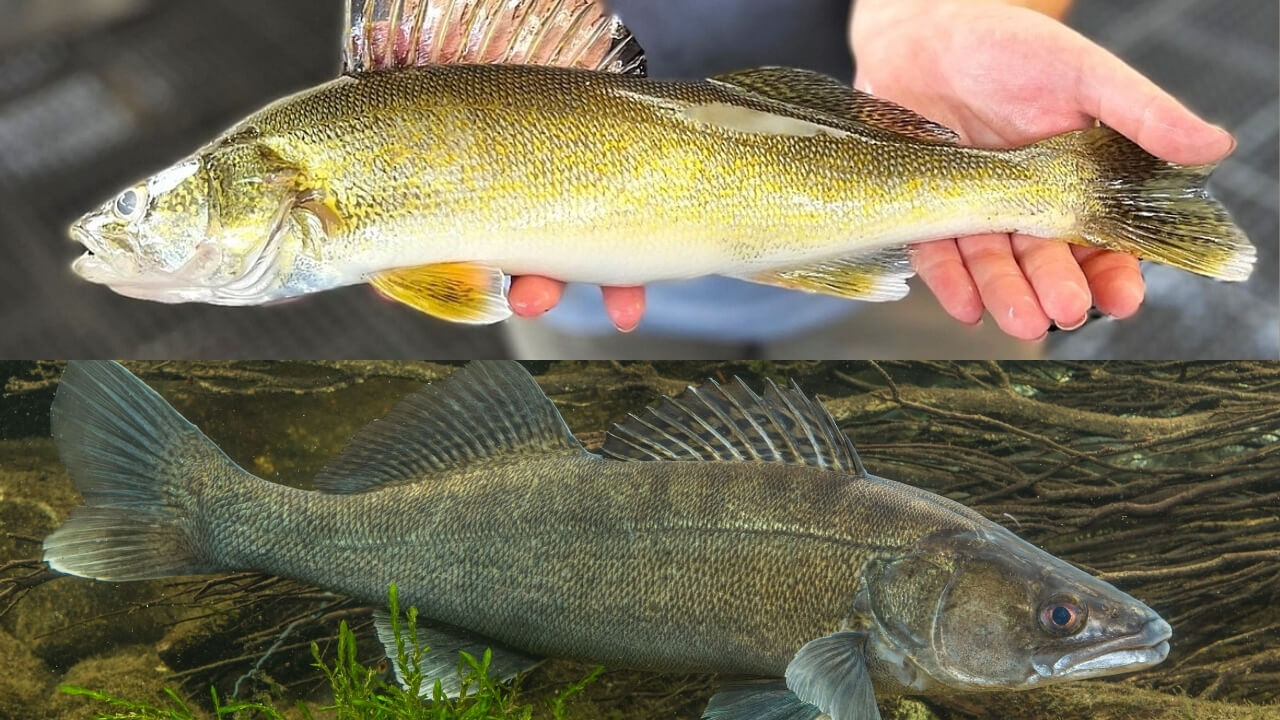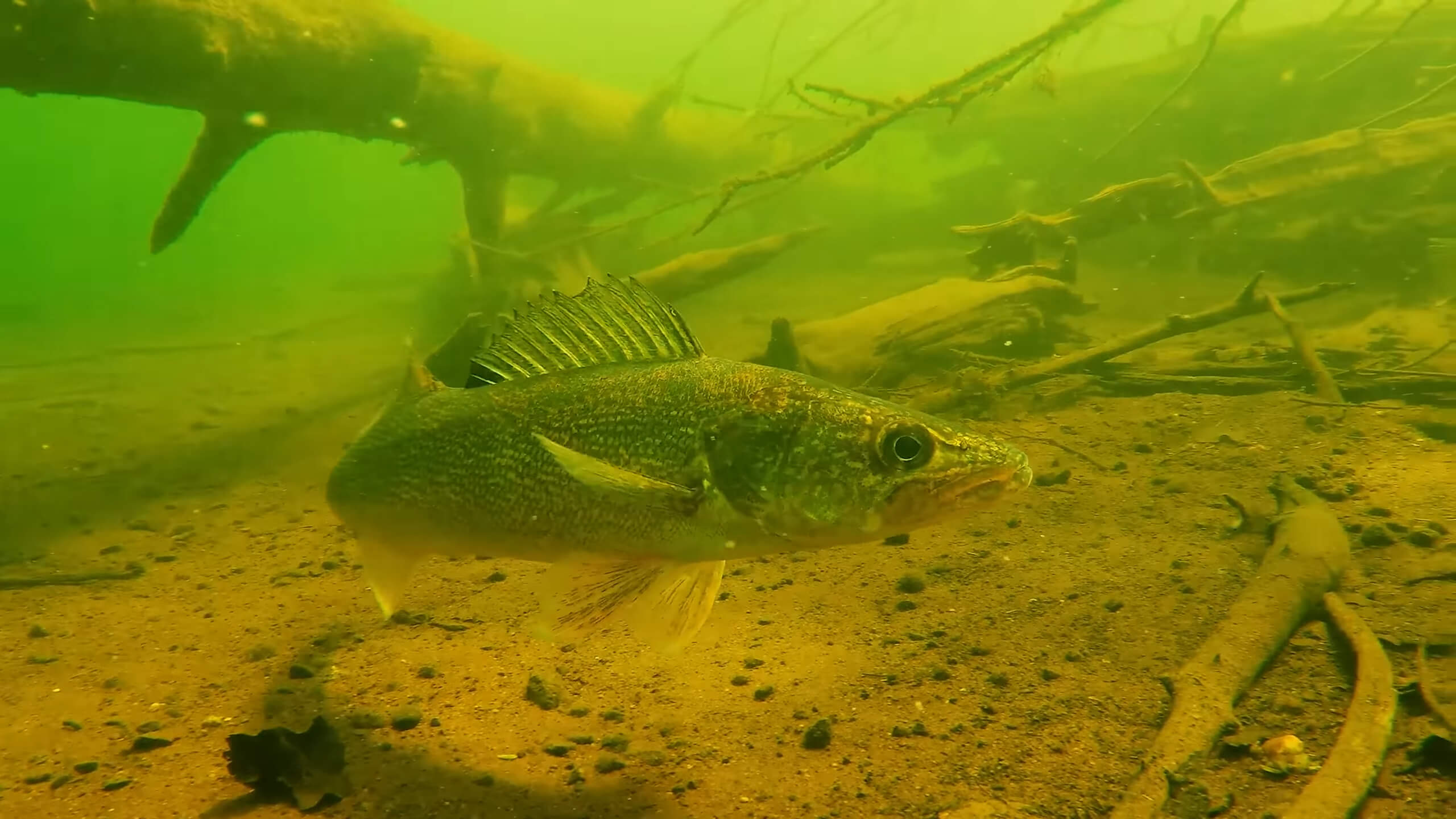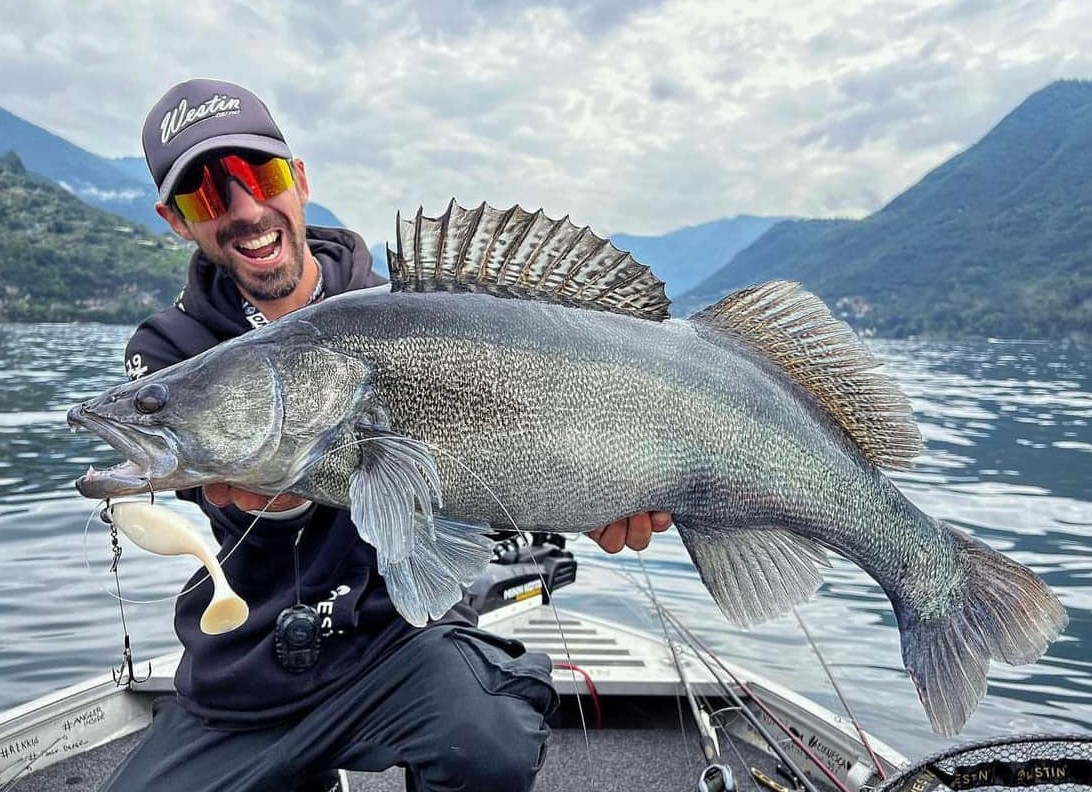Zander and walleye might look like the same fish at first, but they’re not. They have similarities in appearance, but with a few key differences like their size and where they’re found, you can easily tell them apart once you know what to look for.
Let’s break it down so that next time you’re out there, you won’t mistake one for the other.
| Zander | Walleye | |
|---|---|---|
| Size | Up to 42 inches | Up to 32 inches |
| Weight | Up to 30 pounds | Up to 20 pounds |
| Color | Greenish-brown with vertical bars | Olive-gold with brassy flecks |
| Distribution | Europe and Western Asia | North America |
| Preferred Habitat | Deeper, oxygen-rich freshwater lakes | Murky freshwater lakes and rivers |
| Diet | Smaller fish like smelt and roach | Perch, freshwater drum |
| Fishing Methods | Live/dead bait, lures | Lures like crankbaits, soft baits |
| Max Lifespan | Up to 20 years | Up to 26 years |

Size Comparison
| Zander | Walleye | |
|---|---|---|
| Average Size | 15-30 inches | 10-20 inches |
| Maximum Size | Up to 42 inches | Up to 32 inches |
When comparing the size of zander and walleye, zander generally comes out on top. The average length of zander falls between 15 to 30 inches, while walleye tends to be smaller, measuring 10 to 20 inches on average.
In terms of maximum size, zander can grow up to 42 inches, whereas walleye typically maxes out at 32 inches.
Weight
| Zander | Walleye | |
|---|---|---|
| Average Weight | 4-8 pounds | 1-3 pounds |
| Maximum Weight | Up to 30 pounds | Up to 25 pounds |
When it comes to weight, zander is again the heavier of the two species. The average weight of a zander is between 4 to 8 pounds, while a walleye typically weighs much less, averaging 1 to 3 pounds.
For larger specimens, zander can reach up to 30 pounds, whereas the largest walleye usually caps at around 25 pounds.
The weight difference becomes more apparent when dealing with mature fish, as zander’s bulkier frame allows it to grow significantly larger in both length and weight.
Color and Appearance

| Zander | Walleye | |
|---|---|---|
| Main Color | Greenish-brown with vertical bars | Olive-gold with brassy flecks |
| Markings | Vertical stripes along the sides | Brassy flecks, dark saddles on upper body |
| Fins | Spotted dorsal and caudal fins | Plain dorsal fin, white edge on tail fin |
Zander and walleye may look alike at first glance, but there are some clear differences when you know what to check. Zander has a greenish-brown upper body with vertical bars along its sides, giving it a striped appearance.
Its dorsal and caudal fins show rows of black spots. On the other hand, walleye features an olive-gold tone with brassy flecks on its sides and dark saddles along the upper body. Walleye’s tail fin also has a white edge, which zander doesn’t have.
Where Can We Find Them?
| Zander | Walleye | |
|---|---|---|
| Native Region | Europe and Western Asia | North America |
| Found In | Freshwater lakes and rivers | Murky lakes and rivers across the US and Canada |
| Introduced Areas | Spiritwood Lake, North Dakota | Not introduced outside North America |
Zander is native to Europe and Western Asia, where it thrives in freshwater lakes and rivers. It has been introduced to certain areas outside its native region, most notably Spiritwood Lake in North Dakota.
Zander doesn’t naturally exist in North America, making this introduction an exception.
Walleye, on the other hand, is native to North America, specifically in the northern US and Canada. You’ll find walleye in murky freshwater lakes and rivers all across these regions.
Unlike zander, walleye hasn’t been introduced to waters outside of North America.
Habitat

| Zander | Walleye | |
|---|---|---|
| Preferred Waters | Deeper, oxygen-rich lakes and rivers | Murky lakes and rivers with good circulation |
| Water Conditions | Prefers clear, oxygen-rich water | Can tolerate murky, low-light waters |
| Temperature Range | 39-86°F | 32-90°F |
Zander prefers deeper, oxygen-rich freshwater lakes and rivers. It needs clear, well-oxygenated waters and avoids areas with low oxygen. Zander does well in both freshwater and brackish environments, which gives it more range.
Walleye, on the other hand, thrives in murky freshwater lakes and rivers. It handles low-light conditions really well and often stays in areas with good water circulation.
It has a wider temperature tolerance, from cold to warm waters, which lets it survive in a range of habitats.
Diet and Feeding Habits
| Zander | Walleye | |
|---|---|---|
| Primary Diet | Small fish like smelt, roach, perch | Perch, freshwater drum, crayfish |
| Hunting Time | Mostly active at dusk and dawn | Active at dusk, dawn, and nighttime |
| Feeding Style | Chases prey in zigzag patterns | Uses reflective eyes to hunt in low light |
Zander mostly feed on small fish like smelt, roach, and perch. They are aggressive predators, often chasing their prey in zigzag patterns and attacking quickly. Zander are active hunters, especially during dusk and dawn when light is low.
Walleye also feed on fish but tend to go for perch, freshwater drum, and even crayfish when available. Their reflective eyes give them an edge in murky or low-light conditions, making them especially effective hunters at night.
Walleye’s nocturnal feeding habits make them a favorite among anglers during late-night fishing sessions.
Best Ways To Catch Them
| Zander | Walleye | |
|---|---|---|
| Preferred Bait | Live or dead bait, like roach or sprats | Lures like crankbaits, soft baits |
| Fishing Time | Best in the evening and night | Best at night or early morning |
| Fishing Method | Bottom fishing, trolling, jigging | Trolling, casting, jigging |
For zander, live or dead bait like roach or sprats is often used. Anglers usually go for bottom fishing or trolling with soft lures, especially during the evening or at night. Zander are highly active when the light is low, making nighttime fishing productive.
Walleye is more commonly caught using lures, such as crankbaits and soft baits. Anglers tend to rely on trolling, casting, and jigging to attract walleye, and like zander, walleye is best caught at night or early in the morning.
Walleye’s sensitivity to light gives them a natural advantage in darker waters, so nighttime fishing is key for a successful catch.
Lifespan and Growth
| Zander | Walleye | |
|---|---|---|
| Average Lifespan | Up to 20 years | Up to 26 years |
| Growth Rate | Faster in deeper, oxygen-rich waters | Steady growth, but depends on water temperature |
| Maturity Age | 3-4 years | 4-5 years |
Zander can live for up to 20 years, reaching maturity at around 3 to 4 years. They tend to grow faster in environments that are deeper and rich in oxygen. The right water conditions play a huge role in how fast zander can develop.
Walleye, on the other hand, can live up to 26 years, with their growth rate heavily influenced by water temperature. Walleye typically reach maturity a bit later than zander, around 4 to 5 years.
Warmer waters usually mean faster growth, but walleye still follow a steady growth path throughout their lifespan.
FAQs
What’s the best bait to use for zander?
For zander, the best bait is usually live or dead bait, like roach, sprats, or other small fish. Many anglers also have success with soft lures, especially during the evening or night.
Do walleye and zander eat the same things?
Both species are predatory, but their diets differ slightly. Zander prefer smaller fish like smelt, roach, and perch. Walleye go after perch, freshwater drum, and sometimes crayfish.
Why are zander considered a threat to local ecosystems?
Zander can outcompete native fish for food and space. They’re aggressive predators and may disrupt ecosystems if introduced outside their native range, which is why there’s concern in North America.
Can walleye see better in low light than zander?
Both walleye and zander have excellent low-light vision due to their reflective eyes. However, walleye are known for their superior night vision, giving them an edge in murky or dark water.
Are there any restrictions on fishing zander in the US?
Yes, zander are only found in Spiritwood Lake, North Dakota, and introducing them to other bodies of water is illegal due to their potential to become invasive.
Last Words
Zander and walleye may look similar at first, but they have clear differences once you get to know them. Zander are generally larger and have distinct vertical bars on their body, while walleye are smaller with olive-gold coloring.
These two fish also differ in where they live, with zander being native to Europe and Western Asia, and walleye being found in North America.
When it comes to fishing, zander and walleye both thrive in low-light conditions, but they have different bait preferences and habitats.

